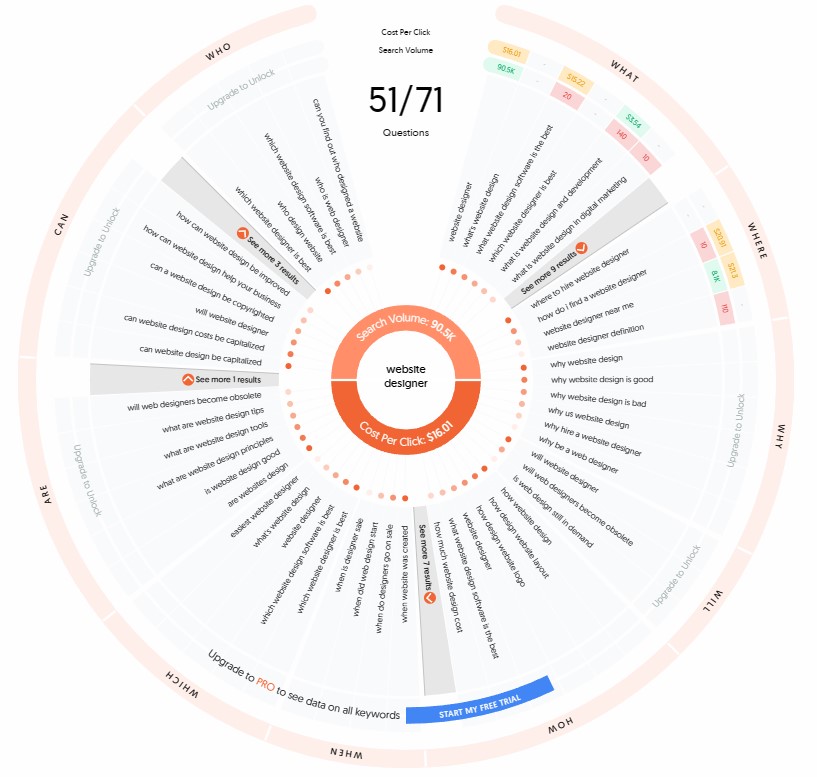Long-Tail Keywords
The Secret Weapon for Niche Targeting in SEO is an untapped goldmine for service-based business owners looking to elevate their online presence. By focusing on these unique search terms, you can tap into a less competitive and more specific market that drives targeted traffic to your doorstep.
This comprehensive guide will help you understand the concept of long-tail keywords and their significance in keyword selection. We’ll delve deep into the benefits of using long-tail keywords for niche targeting, including reduced competition and increased conversions.
Despite limitations with popular keyword research tools, you’ll also learn how to identify potential long-tail keywords from seed words. Moreover, we’ll explore how broad terms can be transformed into profitable long-tailed phrases by adding modifiers or utilizing tools like Answer The Public.
The Secret Weapon for Niche Targeting in SEO offers a powerful toolkit that can drastically enhance your SEO efforts when implemented correctly.
Understanding Long-Tail Keywords
The world of SEO is filled with numerous strategies and tactics, but one that stands out for its effectiveness in niche targeting is using long-tail keywords. These are highly specific phrases consisting of at least three words. They cater to a clear customer need and typically have a low search volume. However, their specificity makes them invaluable tools for attracting qualified leads while facing minimal competition.
Definition of long-tail keywords
Long-tail keywords are specific, often longer, phrases that visitors are more likely to use when they’re closer to the point of purchase or using voice search. They’re highly valuable for SEO for several reasons:
- Lower Competition: Long-tail keywords have lower competition than general keywords. Fewer businesses are trying to rank for these specific phrases, so ranking higher in search results can be easier.
- Higher Conversion Rates: Because they’re so specific, long-tail keywords tend to attract more qualified traffic—users likelier to convert or purchase. For example, someone searching for “black leather sofa free delivery” has a very clear intent compared to someone searching for “sofas.”
- Relevant to Semantic Search: With advancements in machine learning and AI, search engines are getting better at understanding the context behind a search, also known as semantic search. Long-tail keywords fit into this trend because they are more conversational and mimic how people naturally speak or search.
- Voice Search: The rise of voice assistants like Amazon’s Alexa, Google Assistant, and Apple’s Siri has led to an increase in voice search, where people often use full sentences or specific questions—essentially, long-tail keywords.
- Content Topic Ideas: Long-tail keywords can often point to specific questions or topics your audience is interested in. This can be a great source of content ideas that can help attract traffic and build your site’s relevance.
- Better User Experience: By optimizing your content for long-tail keywords, you’re essentially focusing on answering specific queries. This can lead to a better user experience as visitors find exactly what they want on your site.
So, while long-tail keywords might not bring in the highest traffic volume, they often attract more qualified visitors who are more likely to convert, making them a key part of any SEO strategy.
The importance of specificity in keyword selection
In SEO, specificity matters immensely because it helps your content reach those most likely to engage with it and convert into customers. By focusing on longer keyphrases like “website design services for small businesses” rather than generic terms such as “web design,” you can attract more relevant traffic – people looking specifically for your offer – thereby improving your site ranking and conversion rates.
This strategy aligns perfectly with Google’s algorithms, too, since the tech giant has always prioritized providing users with the most accurate results based on their queries. So by using long-tail keywords effectively within your content strategy, you’re playing right into this priority – giving yourself a significant edge over competitors who stick solely to shorter keyphrases.
Long-Tail Keyword Examples for Website Designer

Unlock the power of long-tail keywords for niche targeting in SEO. Increase conversion rates and outshine competitors with specific search phrases.
Benefits of Using Long-Tail Keywords for Niche Targeting
In the vast ocean of SEO, long-tail keywords are like hidden treasures. They offer many benefits that can significantly improve your website’s performance and visibility online.
Reduced competition with long-tail keywords
Less competition means more chances to shine. Long-tail keywords are like the underdogs of SEO. They may not have the popularity of generic terms, but they can help you rank higher in search results and attract more visitors to your site.
Increased conversions through targeted traffic
Get ready for some serious conversions. When people search with long-tail phrases, they know exactly what they want. That means they’re more likely to become your customers once they land on your page. Targeting a specific audience segment with long-tail keywords is like taking advantage of an easy opportunity.
This specificity also makes long-tail keywords perfect for niche targeting. They speak directly to a specific audience segment’s needs and wants. For example, if you run an eco-friendly cleaning service, forget about generic terms like “cleaning services.” Instead, use longer phrases like “eco-friendly home cleaning services in Seattle.” It’s like a bullseye for your target audience.
Premium Websites, Inc., offers a WebHub Keyword Expansion package. This will help greatly with your long-tail keyword strategy.
To sum up: don’t underestimate the impact of carefully chosen long-tails on your online success. They’re the key to unlocking hidden treasures in the SEO world.
Discover the hidden power of long-tail keywords for niche targeting in SEO. Boost your website’s visibility and conversions with this secret weapon.
Identifying Potential Long-Tail Keywords
Uncovering the right long-tail keywords can be the key to bringing targeted visitors to your website. How do you uncover these concealed treasures? It all starts with a list of seed keywords.
Preparing a List of Seed Keywords
A seed keyword is the starting point for your keyword research. Think of them as the big, broad terms related to your business or industry. For example, if you’re in the online bakery biz, your seeds might be “bread,” “cakes,” and “pastries.”
The trick is to align these seeds with what people are searching for. Get inside the minds of your target audience through brainstorming or customer surveys.
How to Identify the Right Phrases for Your Business
Identifying the right long-tail keywords for your business involves understanding your audience, knowing your products/services well, and using SEO tools. Here are some steps to get you started:
- Define Your Offering and Audience: Understand what you are offering and who your target audience is. What problems are you solving? What questions might your customers have about your products or services?
- Brainstorm Potential Keywords: Start by brainstorming potential long-tail keywords related to your products or services. Think about what your audience might search for. Consider location-based terms, comparison terms (like “X vs Y”), how-to terms (like “how to use X”), and so on.
- Use Keyword Research Tools: Use tools like Google Keyword Planner, SEMrush, Ahrefs, Moz Keyword Explorer, or Ubersuggest to find long-tail keywords. These tools can suggest related keywords, show you the search volume, and indicate how competitive those keywords are.
- Analyze Your Competitors: Look at what long-tail keywords your competitors are targeting. Tools like SEMrush or Ahrefs can show you which keywords your competitors rank for.
- Look at Search Queries in Google Search Console: Google Search Console can show you what search queries people use to find your website. This can give you ideas for new long-tail keywords to target.
- Use Google’s Autocomplete and Related Searches: Start typing a query related to your business in Google’s search box and see how Google autocompletes it. This can give you ideas for long-tail keywords. Similarly, at the bottom of the search results page, Google shows related search queries that can provide further ideas.
- Monitor Your Performance: Once you’ve identified and started targeting long-tail keywords, monitor your performance in your analytics tools to see which ones bring in traffic and lead to conversions.
Remember, the goal is to identify long-tail keywords relevant to your business, have a reasonable search volume, and, ideally, lower competition. It’s not just about attracting traffic but attracting the right kind of traffic—visitors who are likely to become customers.
Discover the power of long-tail keywords for niche targeting in SEO. Find hidden gems and attract targeted traffic to your website with Premium Websites, Inc. services.
Transforming Broad Terms Into Long-Tailed Phrases
The art of turning basic search terms into detailed, long-tail keywords is an SEO game-changer. Add modifiers like value or seasonal extras to your seed keywords to make them more specific and targeted.
Adding Modifiers to Get Specific
A modifier can be an adjective (like “premium” or “affordable”) or a location (“Seattle web design services”). These additions make your keywords longer and more specific, reducing competition and attracting relevant traffic. Instead of ‘website design,’ aim for ‘affordable website design for small businesses.’
Tools like Answer The Public
Brainstorming modifiers is great, but tools like Answer The Public can help too. Input a seed keyword and get questions people commonly ask about it. These queries often include useful modifiers for niche targeting. Answer The Public has a free version that allows for 3 queries per day. They also have paid versions with the cheapest plan at $9 per month for 100 searches and downloadable search information.
Answer The Public is just one tool. Platforms like SpyFu or Ahrefs show what competitors rank for, inspiring your set of long-tail keywords.
These strategies help service-based businesses improve rankings and drive traffic by focusing on super-relevant content with well-chosen phrasing – something Google’s algorithms appreciate.
Answer The Pubic Results for Website Designer

Discover the power of long-tail keywords in SEO. Transform broad terms into targeted phrases for niche success.
Organizing Keywords: Making Sense of the Search Madness
So, you’ve got a bunch of potential keyphrases. Time to sift through and determine the most valuable keyphrases. We want only the juiciest, most relevant keywords to make the cut. We can optimize our content and climb those rankings by aligning these gems with what users want.
Pruning: Bye-Bye Irrelevant Options
Pruning is like a keyword makeover. We’re eliminating the dead weight, the irrelevant and ineffective options. We want terms that scream, “Hey, this is what we’re all about.” Tools like Ahrefs or SpyFu can help us see which keywords perform like rockstars.
Aligning with User Intent: Mind Readers, We Are
User intent is like a secret code. We need to crack it to find the perfect keywords. When someone searches, they have a purpose. We need to match that purpose with our long-tail keywords. For example, if someone searches for “best web hosting services,” they probably compare options before deciding.
To nail user intent, let’s categorize our chosen long-tail phrases. We’ve got informational (looking for info), navigational (searching for specific sites), transactional (ready to buy), and commercial investigation (comparing products/services).
This approach helps us create super-relevant content and attract targeted traffic. We’re like a magnet for people actively searching for our solutions.
Unlock the power of long-tail keywords for niche targeting in SEO. Optimize your content and climb those rankings with user intent alignment.
Integrating Keyphrases Within Content Strategy
In the wild world of SEO, content is king. But not just any content; it has to be top-notch and tackle common issues service-based businesses face to reel in that sweet traffic.
Developing Quality Articles to Tackle Common Service-Based Business Issues
The first step in your SEO game plan is crafting killer articles that answer FAQs or dish out useful tips for your audience. Think “How to Boost Customer Service” or “Marketing Magic for Small Businesses.” Providing value to visitors is key to a successful website.
Impact of Super-Relevant Content on Site Ranking and Traffic
It boosts your site ranking and drives a ton of traffic. Users prefer longer keyphrases over generic ones, and Google’s algorithms are all over it.
Creating content with long-tail keywords that targets buyer intent is a strategic approach that can drive high-quality traffic to your website and increase conversions. Here are some steps to help you achieve this:
- Understand Your Buyers: Start by understanding who your buyers are, what they want, and what problems they’re trying to solve. Create buyer personas to help focus your efforts.
- Identify Buyer Intent Keywords: Identify long-tail keywords that signal buyer intent. These might include keywords with terms like “buy,” “price,” “discount,” “deal,” “review,” or “compare.” For example, “best price for Nikon D850 camera” shows buyer intent.
- Create Quality Content: Once you’ve identified your target keywords, create high-quality content around those topics. This might be product reviews, comparison articles, how-to guides, or product tutorials. Ensure your content is valuable, informative, and answers your audience’s questions.
- Use Keywords Naturally: Incorporate your long-tail keywords naturally within your content. This includes the title, headers, meta descriptions, and within the body content itself. But avoid keyword stuffing—ensure the content still reads naturally.
- Include a Call to Action (CTA): Since you’re targeting buyer intent, include a clear CTA that guides users to the next step, whether making a purchase, contacting you, or filling out a form.
- Optimize for SEO: Besides using keywords, remember other SEO practices, such as optimizing images, using internal and external links, and ensuring your page loads quickly.
- Measure and Refine: Use tools like Google Analytics and Google Search Console to measure the performance of your content. Which articles are driving traffic and conversions? Can you identify any patterns in the type of content that performs well? Use this information to refine your approach.
Remember, while targeting buyer intent can be powerful, it’s still important to have a mix of content that targets different stages of the buyer’s journey—from awareness to consideration to decision. This way, you can attract and nurture potential customers at all stages.
Influence of Super-Relevant Content on Site Ranking
Highly relevant content has a massive impact on your site ranking. Google loves quality and relevance, so creating targeted and valuable content can skyrocket your website’s visibility in search results.
How Well-Chosen Phrasing Drives Traffic to Sites
Using well-chosen long-tail keywords in super-relevant content is a traffic magnet. When users search for specific needs or interests (which long-tail phrases capture perfectly), they land on sites that offer exactly what they want – like yours. This precision targeting leads to higher engagement rates as visitors find value in the tailored information presented.
Long-tail keywords are the “secret weapons” in niche markets. They attract qualified leads while reducing competition levels. No wonder businesses flock to experts like Premium Websites, Inc., known for their mastery in leveraging these powerful tools.
Boost your site ranking and drive targeted traffic with super-relevant content. Discover the secret weapon of long-tail keywords in SEO.
FAQs about the Secret Weapon for Niche Targeting in SEO
What is the power of long-tail keywords in SEO?
The power of long-tail keywords lies in their ability to target niche markets, reduce competition, and increase conversion rates by attracting highly specific search traffic.
What are long-tail niche keywords?
Long-tail niche keywords are often used by consumers who know exactly what they want. They usually have lower search volumes but higher conversion rates.
What is the benefit of targeting long-tail keywords for SEO?
The main benefit of targeting long-tail keywords includes reduced competition, increased conversions due to more targeted traffic, and improved site ranking on SERPs (Search Engine Results Pages).
Why do SEOs place heavy emphasis on long-tail keywords?
SEO professionals emphasize long-tail keywords because they help businesses reach a specific audience with high intent – leading to better engagement and conversions.
Conclusion
The Secret Weapon for Niche Targeting in SEO helps service-based biz owners boost online visibility and attract laser-focused traffic.
Understanding long-tail keywords and their low competition will get more conversions!
Find potential long-tail keywords by brainstorming, getting specific, checking social media, and organizing by searcher intent.
Integrate these keyphrases into your content strategy for killer articles that solve common biz problems.
Remember, super-relevant content = higher rankings and more traffic!



